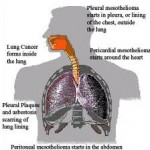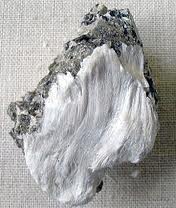- Asbestos is the name given to a group of minerals that occur naturally in the environment as bundles of fibers that can be separated into thin, durable threads. These fibers are resistant to heat, fire, and chemicals and do not conduct electricity. For these reasons, asbestos has been used widely in many industries.
Chemically, asbestos minerals are silicate compounds, meaning they contain atoms of silicon and oxygen in their molecular structure.
Asbestos minerals are divided into two major groups: Serpentine asbestos and amphibole asbestos. Serpentine asbestos includes the mineral chrysotile, which has long, curly fibers that can be woven. Chrysotile asbestos is the form that has been used most widely in commercial applications. Amphibole asbestos includes the minerals actinolite, tremolite, anthophyllite, crocidolite, and amosite. Amphibole asbestos has straight, needle-like fibers that are more brittle than those of serpentine asbestos and are more limited in their ability to be fabricated.
-
How is asbestos used?
Asbestos has been mined and used commercially in North America since the late 1800s. Its use increased greatly during World War II. Since then, asbestos has been used in many industries. For example, the building and construction industries have used it for strengthening cement and plastics as well as for insulation, roofing, fireproofing, and sound absorption. The shipbuilding industry has used asbestos to insulate boilers, steam pipes, and hot water pipes. The automotive industry uses asbestos in vehicle brake shoes and clutch pads. Asbestos has also been used in ceiling and floor tiles; paints, coatings, and adhesives; and plastics. In addition, asbestos has been found in vermiculite-containing garden products and some talc-containing crayons.
In the late 1970s, the U.S. Consumer Product Safety Commission (CPSC) banned the use of asbestos in wallboard patching compounds and gas fireplaces because the asbestos fibers in these products could be released into the environment during use. In addition, manufacturers of electric hairdryers voluntarily stopped using asbestos in their products in 1979. In 1989, the U.S. Environmental Protection Agency (EPA) banned all new uses of asbestos; however, uses developed before 1989 are still allowed. The EPA also established regulations that require school systems to inspect buildings for the presence of damaged asbestos and to eliminate or reduce asbestos exposure to occupants by removing the asbestos or encasing it.
In June 2000, the CPSC concluded that the risk of children’s exposure to asbestos fibers in crayons was extremely low. However, U.S. manufacturers of these crayons agreed to eliminate talc from their products.
In August 2000, the EPA conducted a series of tests to evaluate the risk for consumers of adverse health effects associated with exposure to asbestos-contaminated vermiculite. The EPA concluded that exposure to asbestos from some vermiculite products poses only a minimal health risk. The EPA recommended that consumers reduce the low risk associated with the occasional use of vermiculite during gardening activities by limiting the amount of dust produced during vermiculite use. Specifically, the EPA suggested that consumers use vermiculite outdoors or in a well-ventilated area; keep vermiculite damp while using it; avoid bringing dust from vermiculite into the home on clothing; and use premixed potting soil, which is less likely to generate dust.
The regulations described above and other actions, coupled with widespread public concern about the health hazards of asbestos, have resulted in a significant annual decline in the U.S. use of asbestos. Domestic consumption of asbestos amounted to about 803,000 metric tons in 1973, but it had dropped to about 2,400 metric tons by 2005.
-
What are the health hazards of exposure to asbestos?
People may be exposed to asbestos in their workplace, their communities, or their homes. If products containing asbestos are disturbed, tiny asbestos fibers are released into the air. When asbestos fibers are breathed in, they may get trapped in the lungs and remain there for a long time. Over time, these fibers can accumulate and cause scarring and inflammation, which can affect breathing and lead to serious health problems.
 Asbestos has been classified as a known human carcinogen (a substance that causes cancer) by the U.S. Department of Health and Human Services, the EPA, and the International Agency for Research on Cancer. Studies have shown that exposure to asbestos may increase the risk of lung cancer and mesothelioma (a relatively rare cancer of the thin membranes that line the chest and abdomen). Although rare, mesothelioma is the most common form of cancer associated with asbestos exposure. In addition to lung cancer and mesothelioma, some studies have suggested an association between asbestos exposure and gastrointestinal and colorectal cancers, as well as an elevated risk for cancers of the throat, kidney, esophagus, and gallbladder. However, the evidence is inconclusive.
Asbestos has been classified as a known human carcinogen (a substance that causes cancer) by the U.S. Department of Health and Human Services, the EPA, and the International Agency for Research on Cancer. Studies have shown that exposure to asbestos may increase the risk of lung cancer and mesothelioma (a relatively rare cancer of the thin membranes that line the chest and abdomen). Although rare, mesothelioma is the most common form of cancer associated with asbestos exposure. In addition to lung cancer and mesothelioma, some studies have suggested an association between asbestos exposure and gastrointestinal and colorectal cancers, as well as an elevated risk for cancers of the throat, kidney, esophagus, and gallbladder. However, the evidence is inconclusive.
Asbestos exposure may also increase the risk of asbestosis (an inflammatory condition affecting the lungs that can cause shortness of breath, coughing, and permanent lung damage) and other nonmalignant lung and pleural disorders, including pleural plaques (changes in the membranes surrounding the lung), pleural thickening, and benign pleural effusions (abnormal collections of fluid between the thin layers of tissue lining the lungs and the wall of the chest cavity). Although pleural plaques are not precursors to lung cancer, evidence suggests that people with pleural disease caused by exposure to asbestos may be at increased risk for lung cancer.

